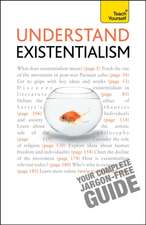Non-Metaphysical Theology After Heidegger
Autor Peter S. Dillarden Limba Engleză Hardback – 21 iun 2016
| Toate formatele și edițiile | Preț | Express |
|---|---|---|
| Paperback (1) | 380.63 lei 6-8 săpt. | |
| Palgrave Macmillan US – 30 mai 2018 | 380.63 lei 6-8 săpt. | |
| Hardback (1) | 385.84 lei 6-8 săpt. | |
| Palgrave Macmillan US – 21 iun 2016 | 385.84 lei 6-8 săpt. |
Preț: 385.84 lei
Nou
Puncte Express: 579
Preț estimativ în valută:
73.84€ • 76.62$ • 61.72£
73.84€ • 76.62$ • 61.72£
Carte tipărită la comandă
Livrare economică 15-29 martie
Preluare comenzi: 021 569.72.76
Specificații
ISBN-13: 9781137584793
ISBN-10: 1137584793
Pagini: 178
Ilustrații: X, 185 p.
Dimensiuni: 148 x 210 x 18 mm
Greutate: 0.36 kg
Ediția:1st ed. 2016
Editura: Palgrave Macmillan US
Colecția Palgrave Macmillan
Locul publicării:New York, United States
ISBN-10: 1137584793
Pagini: 178
Ilustrații: X, 185 p.
Dimensiuni: 148 x 210 x 18 mm
Greutate: 0.36 kg
Ediția:1st ed. 2016
Editura: Palgrave Macmillan US
Colecția Palgrave Macmillan
Locul publicării:New York, United States
Cuprins
Introduction: What Has Jerusalem to Do with Totdnauber?.- 1. Is There Any Such Thing as What Heidegger Calls Thinking?.- 2. From Proto-Theology to Phenomenology.- 3. Deconstructive Scriptural Meaning.- 4. A Pair of Ledgers.- 5. A Word from Marburg.- 6. Objectivity without Objects.- 7. From Phenomenology to Agency.- 8. Why Only a God Can Save Us: Atonement.- 9. The Thickness of Things and the Godding of Gods: Eucharist, Discipleship, and Trinity
Conclusion: Yes and No.
Notă biografică
Peter S. Dillard is the author of Heidegger and Philosophical Atheology: A Neo-Scholastic Critique (2008), A Way into Scholasticism: A Companion to St. Bonaventure’s The Soul’s Journey into God (2011), Foundation and Restoration in Hugh of St. Victor’s De Sacramentis (2014), and numerous scholarly articles.
Textul de pe ultima copertă
Using Martin Heidegger’s later philosophy as his springboard, Peter S. Dillard provides a radical reorientation of contemporary Christian theology. From Heidegger’s initially obscure texts concerning the holy, the gods, and the last god, Dillard extracts two possible non-metaphysical theologies: a theology of Streit and a theology of Gelassenheit. Both theologies promise to avoid metaphysical antinomies that traditionally hinder theology. After describing the strengths and weaknesses of each non-metaphysical theology, Dillard develops a Gelassenheit theology that ascribes a definite phenomenology to the human encounter with divinity. This Gelassenheit theology also explains how this divinity can guide human action in concrete situations, remain deeply consonant with Christian beliefs in the Incarnation and the Trinity, and shed light on the Eucharist and Religious Vocations. Seminal ideas from Rudolf Otto and Ludwig Wittgenstein are applied at key points. Dillard concludes by encouraging others to develop an opposing Streit theology within the non-metaphysical, Heidegerrian framework he presents.














